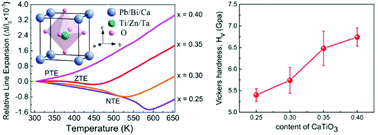Tunable thermal expansion and high hardness of (0.9−x)PbTiO3–xCaTiO3–0.1Bi(Zn2/3Ta1/3)O3 ceramics†
Abstract
Functional materials with tunable thermal expansion behaviors have important merits for practical applications. Here we designed and synthesized a series of solid solutions, (0.9−x)PbTiO3–xCaTiO3–0.1Bi(Zn2/3Ta1/3)O3, whose coefficients of thermal expansion (CTEs) could be effectively tuned from negative to positive by the substitution of Ca2+ at the A-site. Notably, a zero thermal expansion (ZTE) compound was achieved around x = 0.35 with a linear CTE of −0.099 × 10−5 K−1 over a wide temperature range from 125 K to 465 K. The present experimental and theoretical evidence directly reveals that the spontaneous polarization originating from the cation–oxygen hybridization is closely associated with the tunable thermal expansion. The spontaneous polarization displacement of the compounds decreases with the increase in the content of CaTiO3, leading to a smaller coefficient of volumetric thermal expansion. Moreover, the present samples can be prepared as compacted ceramics with excellent mechanical properties.



 Please wait while we load your content...
Please wait while we load your content...